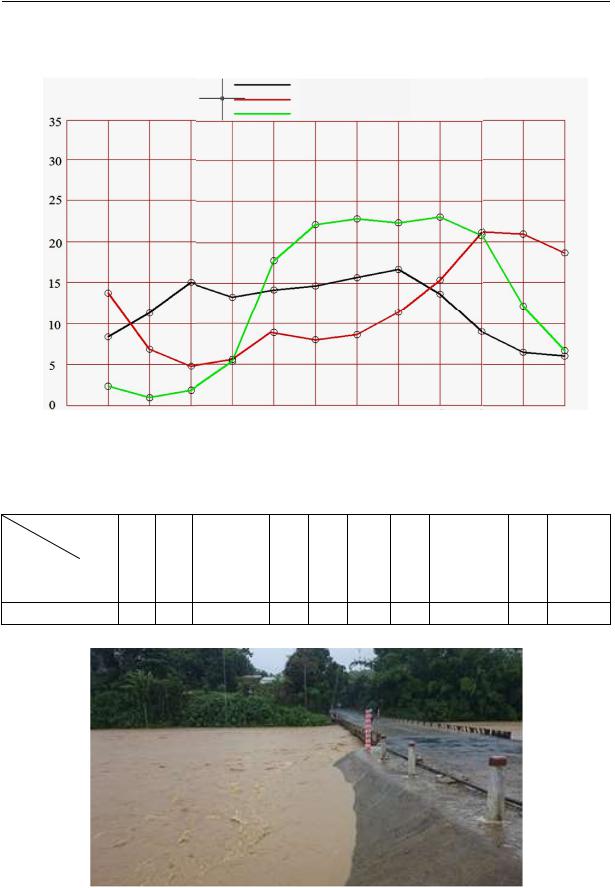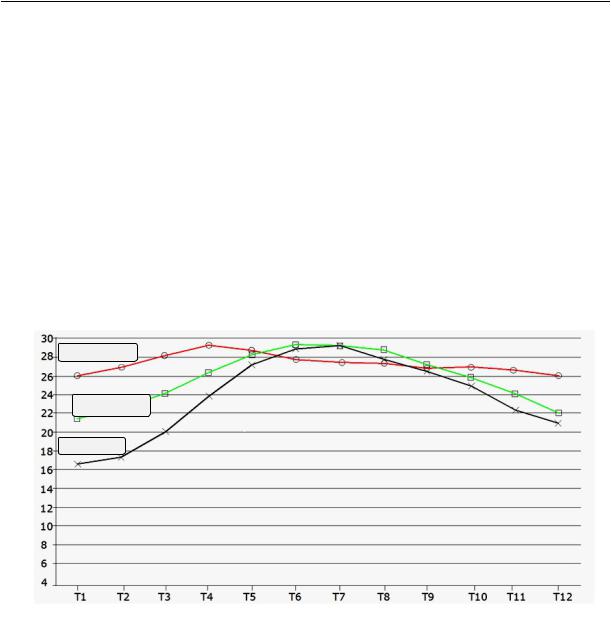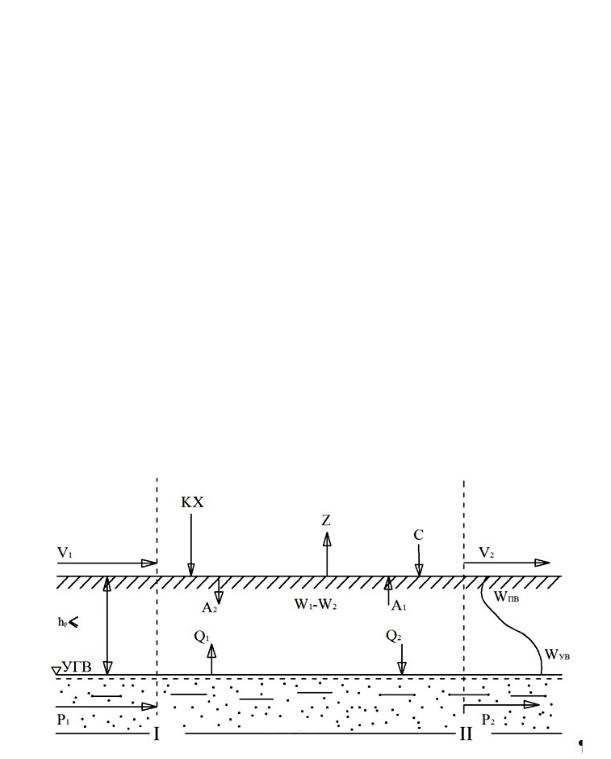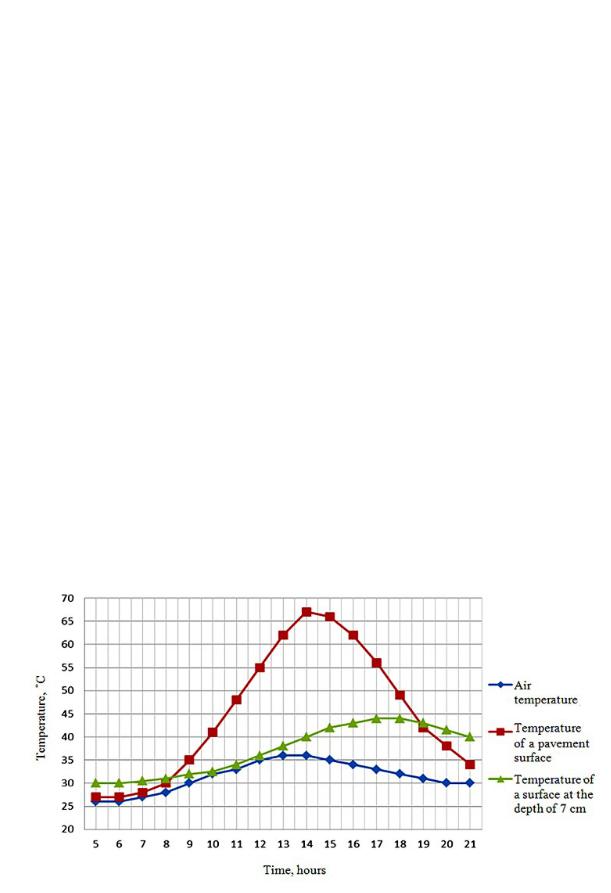
3553
.pdf
Issue № 1(33), 2017 |
ISSN 2542-0526 |
3500 mm/year of rainfall cause flooding of roadways that last from a few hours to a few weeks (Fig. 4).
Hanoi
Danang
Ho Chi Minh
Average annual number of rainy days
|
January |
February |
|
March |
April |
May |
June |
July |
August |
September |
October |
November |
December |
|
|
Fig. 3. Average annual rainfall in different areas of Vietnam |
|
|
|
||||||||
|
|
|
|
|
|
|
|
|
|
|
|
|
Table |
|
|
|
|
|
Amount of rainfall, mm/day |
|
|
|
|
|
|||
Month |
I |
II |
III |
IV |
V |
VI |
VII |
VIII |
IX |
X |
XI |
XII |
Average |
Area |
|
|
|
|
|
|
|
|
|
|
|
|
|
Southern |
15 |
4 |
13 |
42 |
221 |
331 |
314 |
268 |
334 |
268 |
114 |
56 |
165 |
Central |
101 |
31 |
12 |
18 |
47 |
42 |
99 |
117 |
447 |
530 |
221 |
208 |
156 |
Northern |
18 |
28 |
38 |
81 |
197 |
238 |
322 |
343 |
252 |
98 |
42 |
21 |
140 |
Fig. 4. Following a rainfall (the mouth of the Wang River in km 32+650)
51

Russian journal of building construction and architecture
When the moisture off a road surface or gutter cannot cannot flow, it drips through the surface and slopes into the subgrade. The subgrade becomes more plastic as a result of staying wet and thus turns into a paste and then a liquid accomoanied by considerable losses in the strength and resistance to exterior loads (up to 30—60 % for sandy-loam and loamy subgrades and 70—80 % for dust types), which causes deformations of a roadway. Therefore excessive humidity is one of the natural factors in Vietnam that has a particularly significant impact on the physical and mechanical properties of subgrades since the amount of moisture (accumulation of moisture) is central to the connection between solid particles of a road structure. The analysis of the temperature in Vietnam (Fig. 5) points out significant differences not only from month to month but also from an area to area.
Southern area
Central area
Northern area
Fig. 5. Graph of changes in the temperature depending on the season
I.A. Zolotar, N.A. Puzakov, V.M. Sidenko [1] concluded that:
––as the temperature changes in the construction layers of the subgrade, there are constant diffusion processes (heating, cooling, evaporation, condensation) thus resulting in heat exchange and transformation of moisture (vapour);
––changes in the characteristics of the water and heat mode have an impact on the strength, durability of the subgrade, coating of a pavement, which results in degrading transportation and operational properties of road structures;
––an impact of the environment on a road structure is determined by the type and strength of a source of moisture and intensity of temperature effects.
52

Issue № 1(33), 2017 |
ISSN 2542-0526 |
The major task of calculating water and thermal processes is to predict the humidity of a subgrade. Existing methods of predicting the humidity of subgrades is largely based on analysing a water balance equation:
V VC VИ VВ, |
(1) |
where V is the total of the rainfall over a certain period; VD, VE, VA are drainage, evaporation and humidity absorption for a surface unit respectively.
Considering the scheme of water exchange of a specified subgrade layer with the atmosphere (Fig. 6), the water balance equation can be presented using the dependence:
С W1 –W2 (Q1 –Q2) Z (V2 –V1) (G2 –G1) (S2 – S1) (P2 – P1), |
(2) |
where C is the condensation of water vapour; Z is the total evaporation off a surface; V1 and V2 are drainage of surface water; G1 and G2 are inflow and outflow of the soil moisture in a specified layer hР; S1 and S2 are inflow and outflow of groundwater in a specified layer hУГВ — hР; P1 and P2 are inflow and outflow of groundwater; W1 and W2 are humidity of subgrade in a layer h at the start and end of a specified period; Q1 and Q2 are humidity supplies in a layer hР на at the start and end of a specified period.
1,5 m
Aquifuge
Fig. 6. Scheme of humidity exchange of a specified subgrade layer with the atmosphere |
|
Following the transformation the equation (2) is as follows |
|
КХ (W1 –W2) (P2 – P1) V, |
(3) |
where |
|
V (V2 –V1) (P2 – P1). |
|
53

Russian journal of building construction and architecture
The left part of the dependence (3) contains the input elements that are all responsible for the water resources of an area. In the right part there are two balance components (evaporation Ζ and drainage V) that enable control of moisture in (W1 – W2) in subgrade soils.
The major condition of the stability and strength of the “pavement – subgrade” system in Vietnam’s weather conditions is preventing soild from being excessively wet or the humidity of a subgrade from changing too drastically.
Analyzing the mutual dependence “environment-road structures” in Vietnam, it is necessary to note that there is an extra factor that has a direct influence on the quality of asphalt concrete pavements. At all of the altitudes of Vietnam its gets sufficient solar radiation — 130 kcal/сm2 per eyar. The amount of sunny days per year in Northern Vietnam is about 1500—1700 hours, in Central and Southern it is 2000—2600 hours. The temperature mode of an asphalt concrete pavement is known to be a major factor contributing to the stress-strain and life cycle of asphalt concrete road pavements. The temperature of an asphalt concrete pavement is the function of the air temperature which is largely dependent on solar radiation, motion of temperatures in the subgrade soil and many other factors.
According to cyclic changes in the air temperature and solar radiation in layers of asphalt concrete pavements that are at some deep level, the amplitude of temperature oscillations is smaller than on a surface layer with daily temperature maximums taking a while to become stable. As a result, in different layers of an asphalt concrete pavement, a temperature gradient may get as high as 20—30 ˚С, which obviously has an impact on its load-bearing capacity (Fig. 7).
Fig. 7. Average daily temperature oscillations of an asphalt concrete pavement (km 621 of the highway I-А) [7]
54

Issue № 1(33), 2017 |
ISSN 2542-0526 |
The dependence of the temperature of a pavement on that of the environment is theoretically accounted for based on a thermal balance equation. In order to determine the maximum temperatures of pavements, in accordance with [4], the following formula can be made use of:
ТП ТВ ТЭКВ, |
(4) |
where ТP is the temperature of a pavement, °С; ТA is the temperature of the air, °С; ТEQ is the equivalent temperature, °С.
The equivalent temperature is a sort of an additive that is dependent on extra heating of a surface with solar rays:
(5) where А is an albedo of a surface typical of a reflective capacity; J is the intensity of solar radiation, Watt/m2; ad is the heat transfer coefficient determined with a ratio of the density of a heat flow reflected off a surface to the difference in the temperatures between the surface and an adjoining environment, Watt/(m2·degree).
Intensive heating of a road pavement with solar rays leads to higher plasticity of asphalt concrete, which is due to the viscosity of bitumen in asphalt concrete is down and there is a weaker connection between mineral particles resulting in lower strength and deformation growth under wheels –– cracks, waves, ruts, etc. Poor condition of a road pavement contributes to the degradation of users’ properties –– speed, continuity, traffic safety. Transport has a fundamental role in the development of open market economy in Vietnam.
Therefore evaluating the durability of asphalt concrete to predict its life cycle is the major issue in the Southern and Central Vietnam in the dry season with its typical high air temperature in combination with a high amount of solar radiation.
3. Developing the strategy for the maintenance of structures in the weather conditions of Vietnam. Considering diverse weather conditions of Vietnam, types of deformations and failures of road structures, a variety of routine construction technologies, maintenance and refurbishment of subgrades and pavements in challenging and at times aggressive operational conditions, it is necessary to develop a strategy for road maintenance thus with minimum costs delivering the maximum outcome that would eventually lead to a better quality of the entire road transport network.
As there is no agreement as to the standard methods of predicting life cycles of asphalt concrete, after analyzing them the following conclusion can be drawn: for varying weather and operational conditions the performance of asphalt concrete can be described using characteristics of its different properties. Hence evaluation of the operational condition of a pavement mainly focus
55

Russian journal of building construction and architecture
on the properties of materials, distribution gradients, intensity of solar radiation, wind, rain, external loads, etc. The simplex method is most effective (algorithm for optimizing linear programming by selecting the tops of cones in a multidimensional space). The method involves designing basic feasible solutions where the linear functional goes down monotonously until the necessary conditions of local optimality. This allows either to find an optimal solution or to establish that there is no one.
The essence of the simplex method is the following:
––to find out a method of identifying the optimal back-up solution;
––to establish how a transmission is made from one solution to another where the value of the objective function is closer to the optimal one, i.e. to find out how the back-up solution could be improved;
––to specify criteria that allows one either to cut short the selection of back-up solutions on the optimal oneorto concludethereis no one.
Operational properties that contribute to failure of the structure of asphalt concrete can be classed into three major groups:
––impact of transport on asphalt concrete of a road structure;
––impact of the environment causing degrading structural and mechanical characteristics of asphalt concrete;
––impact of the factors associated with the operation of asphalt concrete pavements.
As these factors are investigated further, there are new, previously unknown ones that influence the durability and reliability of asphalt concrete pavements. Depending on them, quantitative characteristics of life cycles of road pavements might change as well. An example of the calculation of thetime before a crack emergeson an asphalt concretepavement is shownin Fig.8.
The major method of improving the strength and durability of road structures is to increase the strength and stability of the subgrade as it is the msot vulnerable part of a structure [18]. Given the weather conditions of Vietnam, the following can be recommended to maintain and reinforce the subgrade embankment:
––when a level of ground waters has a significant effect on the humidity of the operating layer of the subgrade and in order to prevent the rainfall moisture from penetrating it out of the ruts and slopes, ditches should be drained;
––in order to prevent the rainfall moisture from penetrating the subgrade body through unattended ruts or waterproof ones, in order to prevent the rainfall moisture from penetrating a failing asphalt concrete pavement as well as to prevent the embankment subgrade from ditches in the periodof autumn groundwater,itis recommendedtousethe hydroisolation of the subgrade;
56

Issue № 1(33), 2017 |
ISSN 2542-0526 |
–– for drainage of surface water and edge of the subgrade of long-term groundwater it is recommended to use ditches, back-up ditches by arranging slopes or designing terraces;
|
Composition of an asphalt |
|
|
|
concrete mix |
|
|
Transport loads |
Water and |
Water and thermal |
|
thermal impact |
|||
|
impact |
||
|
|
Structure of road pavement and its asphalt concrete
Stretching strains σ (t, T) and their impact time t (σ, T)
Rheological prop- |
Water resistance of |
|
|
erties of asphalt |
asphalt concrete: |
Long-term tensile |
|
concrete: modulus |
Tensile strength of |
||
strength |
|||
E (t, T) and effec- |
asphalt concrete |
||
τ (σ, T) |
|||
tive viscosity |
under bending |
||
|
|||
ƞ (σ, T) |
τ (σ, T) |
|
Bayley criterion
No |
Yes |
Durability |
|
|
|
|
|
of asphalt concrete |
Fig. 8. Block scheme for calculating the time before a crack emerges on an asphalt concrete pavement using the simplex method
–– in areas with stable excessive rainfall moistening and where there is no surface drainage at a high groundwater level it is recommended that roadways are refurbished with the subbase is made of fine-grained materials – hydroisolation sublayer. Th is structure allows water coming through a pavement and ruts to be intercepted and the humidity of the operating layer of the subgrade to be decreased and its load-bearing capacity to be improved. All of the above are routine measures performed to reinforce and improve the quality of a
57

Russian journal of building construction and architecture
pavement. They do not address the water and thermal balance of highways completely as do not account for particular conditions of an area, thus when applied for a specific road, it should consider local weather conditions.
Conclusions
1.An effect of atmospheric (humidity, temperature, solar radiation), hydrological (moistening of the subbase, changes in the soil temperature) and transport (dynamic impacts, vertical loading) factors contributingto the qualityof roadstructures of Vietnam can be classed into twotypes:
–– impact on the subgrade and pavement as a load-bearing structure resulting in changes in its strength, durability and performance;
–– impact on the pavement coating as a rolling surface resulting in changes in the state of its surface, rolling resistance, adhesion and thus a poorer “car-road” connection.
2.When choosing a technology for the maintenance and refurbishment of defects of subgrade and pavement, it is essential to cosnider the influence of a variety of weather and conditions that are Vietnam’s reality. It is only after the major cause of failure of road structures that a technology for the maintenance and refurbishment of road structures.
References
1.I. A. Zolotar' [i dr.]. Vodno-teplovoy rezhim zemlyanogo polotna i dorozhnykh odezhd [Water-heat mode of the subgrade and road pavement]. Moscow, Transport Publ., 1971. 415 p.
2.Dedova I. N., Dau Khoang Khyng. Otsenka sostoyaniya transportnoy infrastruktury V'etnama [Assessment of transport infrastructure of Vietnam]. Transportnoe delo Rossii, 2011, no. 7, pp. 13––17.
3.Evgen'ev I. E., Kazarnovskiy V. D. Zemlyanoe polotno avtomobil'nykh dorog na slabykh gruntakh [The subgrade of roads on weak soils]. Moscow, Transport Publ., 1976. 269 p.
4.Kovalev Ja. N., Kravchenko S. E., Shumchik V. K. Dorozhno-stroitel'nye materialy i izdelija [Road construction materials and products]. Moscow, Novoe znanie Publ., 2013. 630 p.
5.Kozhevnikov, R. A., Dedova I. N., Rezer A. V., Dau Khoang Khyng Obosnovanie prioritetov raz-vitiya transportnogo kompleksa V'etnama [Substantiation of priorities of transport development in Vietnam].
Transportnoe delo Rossii, 2012, no. 3, pp. 51––56.
6.Nguen V. L. Predlozheniya po raschetu konstruktsiy dorozhnykh odezhd s uchetom koleeustoychi-vosti pri povyshennykh temperaturakh v usloviyakh V'etnama [Suggestions for the design of road structures, taking into account coleoptile at elevated temperatures in the environment of Vietnam]. Nauchnyy vestnik Voronezhskogo GASU. Stroitel'stvo i arkhitektura, 2013, no. 2(30), pp. 74—82.
7.Nguen V. L., Chernousov D. I. Prichiny koleeobrazovaniya na asfal'tobetonnykh pokrytiyakh i metody povysheniya ikh deformativnoy ustoychivosti v usloviyakh Yuzhnogo V'etnama [Causes of cleaopatra on asphalt pavements and methods of increasing their deformation resistance in the conditions of South Vietnam].
Nauchnyy vestnik Voronezhskogo GASU. Stroitel'stvo i arkhitektura, 2013, no. 1(29), pp. 57—65.
58

Issue № 1(33), 2017 |
ISSN 2542-0526 |
8.Nguen F. N. Prichiny razrusheniya asfal'tobetonnykh pokrytiy i metody povysheniya ikh de-formativnoy ustoychivosti v usloviyakh V'etnama [The causes of destruction of asphalt-concrete coatings and methods of increasing their deformation resistance in the environment of Vietnam]. Nauchnyy vestnik Voronezhskogo GASU. Stroitel'stvo i arkhitektura, 2015, no. 2(38), pp. 75—83.
9.Podol'skiy Vl. P., Nguen Van Long, Nguen Dyk Shi. Issledovanie temperaturnogo rezhima asfal'tobetonnykh pokrytiy avtomobil'nykh dorog vo V'etname [Investigation of temperature regime of asphalt concrete pavement of roads in Vietnam]. Nauchnyy vestnik Voronezhskogo GASU. Stroitel'stvo i arkhitektura, 2012, no. 4(28), pp. 78—84
10.Podol'skiy Vl. P., Nguen Van Long, Nguen Dyk Shi. O vozmozhnosti rasshireniya resursnoy bazy dorozhnogo stroitel'stva za schet stabilizatsii i ukrepleniya gruntov [About the possibility of expanding the resource base of road construction due to the stabilization and strengthening of soil]. Nauchnyy vestnik Voronezhskogo GASU. Stroitel'stvo i arkhitektura, 2014, no. 1(33), pp. 102—111.
11.Podol'skiy Vl. P., Glagol'ev A. V., Pospelov P. I. Tekhnologiya i organizatsiya stroitel'stva avtomobil'nykh dorog: v 2 t. T. 1. Zemlyanoe polotno [Technology and organization of construction of roads: in 2 vol. Vol. 1. Roadbed]. Voronezh, Izd-vo Voronezh. gos. un-ta, 2005. 528 p.
12.Ryabova O. V., Chan V. Z. Obosnovanie meropriyatiy po zashchite otkosov poymennykh nasypey v'etnamskikh avtomobil'nykh dorog ot kavitatsionnykh i suffozionnykh deformatsiy [Justification of measures for the protection of slopes of embankments floodplain Vietnamese roads from cavitation and suffosion deformations]. Inzhenernye sistemy i sooruzheniya, 2014, vol. 3, no. 4(17), pp. 126—133.
13.Ryabova, O. V., Chan V. Z. Osnovnye printsipy primeneniya traversov dlya inzhenernoy zashchity dorozhno-transportnykh sooruzheniy na poymennykh uchastkakh [Basic principles on the use of beams for engineering protection of road facilities in floodplain areas]. Nauchnyy vestnik Voronezhskogo GASU. Stroitel'stvo i arkhitektura, 2013, no. 4(32), pp. 100—106.
14.Ryabova O. V., Nguen Fyong Ngok. Predlozheniya po reglamentirovaniyu pridorozhnogo pro-stranstva dlya dorog Republiki V'etnam [Proposals for the regulation of roadside space for roads of Republic of Vietnam]. Inzhenernye sistemy i sooruzheniya, 2014, vol. 3, no. 4(17), pp. 112—118.
15.Ryabova O. V., Glagol'ev A. A., Chan V. Razrabotka meropriyatiy po inzhenernoy zashchite av-todorog na poymennykh uchastkakh [Elaboration of measures on engineering protection of roads in floodplain areas].
Fundamental'nye issledovaniya, 2016, no. 4––2, pp. 316—322.
16.Samodurova T. V., Tyong N. V. Bazy dannykh dlya proektirovaniya nezhestkikh dorozhnykh odezhd dlya Respubliki V'etnam [Database for the design of non-rigid road pavements in the Republic of Vietnam].
Nauchnyy vestnik Voronezhskogo GASU. Stroitel'stvo i arkhitektura, 2015, no. 4(40), pp. 72—78.
17.Samodurova T. V., Tyong N. V., Bondarev A. B. Sovershenstvovanie norm proektirovaniya transportnykh sooruzheniy dlya Respubliki V'etnam [Improving design standards of transport facilities in the Republic of Vietnam]. Nauchnyy vestnik Voronezhskogo GASU. Stroitel'stvo i arkhitektura, 2012, no. 4(28), pp. 64—69.
18.Vasil'eva A. P. (red.) Spravochnaya entsiklopediya dorozhnika: v 2 t. T. 2. Remont i soderzhanie avtomobil'nykh dorog [Reference encyclopedia road: in 2 vol. Vol. 2. Repair and maintenance of roads]. Moscow, 2004. 805 p.
19.Chan Van Zy., Podol'skiy Vl. P. Problemy povysheniya deformativnoy ustoychivosti v'et-namskoy dorozhnoy seti na perekhodakh cherez poymu rek [The problem of increasing the deformation resistance of the
59

Russian journal of building construction and architecture
Vietnamese road network on transitions across the floodplain of rivers]. Nauchnyy vestnik Voronezhskogo GASU. Stroitel'stvo i arkhitektura, 2014, no. 4(36), pp. 103—112.
20.Chan Khoang Tkhyong. Znachenie razvitiya transportnoy sistemy v modernizatsii ekonomiki sotsialisticheskoy Respubliki V'etnam [The importance of the development of the transport system in modernization of economy of the socialist Republic of Vietnam]. Transportnoe delo Rossii, 2010, no. 12, pp. 159—161.
21.Chan Khoang Tkhyong. Problemy i strategii razvitiya avtomobil'nogo transporta sotsialisti-cheskoy Respubliki V'etnam [].Challenges and strategies of developing road transport of the socialist Republic of Vietnam. Transportnoe delo Rossii, 2011, no. 4, pp. 87—89.
22.Seredin P. V., Glotov A. V., Domashevskaya E. P., etc. Structural and optical investigations of AlxGa1xAs:Si/GaAs(100) MOCVD heterostructures. PHYSICA B-CONDENSED MATTER, 2010, vol. 405, iss. 22, pp. 4607––4614.
60
